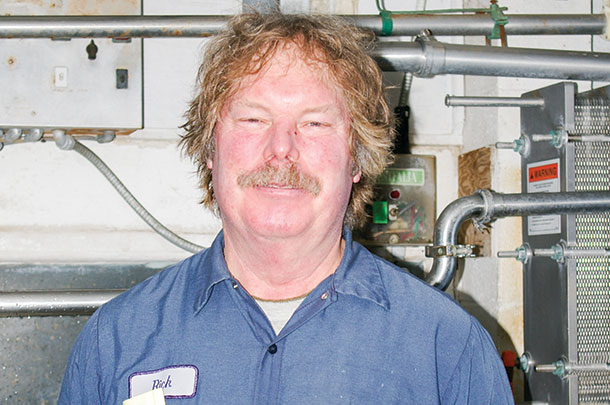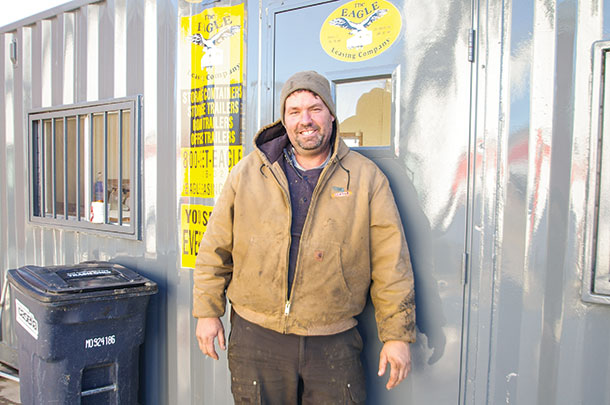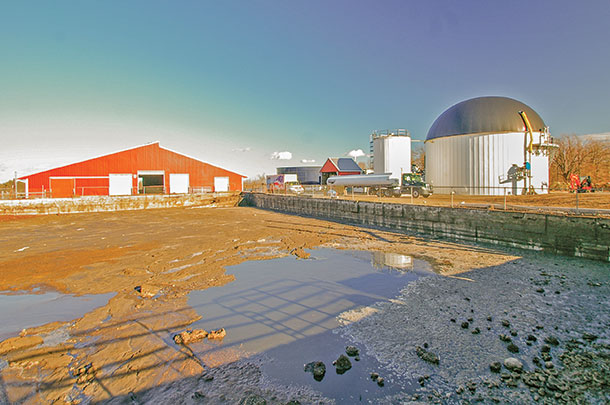For all dairy farms, big and small, managing and disposing of manure is a never-ending job. It’s bothersome to have around and the odor can be offensive, by far the number one reason the non-farming public criticizes animal agriculture.
Manure poses a health hazard since it’s an ideal growth medium for E. coli and salmonella, as well as a breeding ground for vectors that also spread disease. When not stored or handled properly, manure becomes a prime pollutant in public water supplies and other riparian habitat.
At the same time, manure is the single most valuable resource for growing crops and improving soil quality. However, in many cases, especially on large cattle operations, there’s far more manure produced than there is available cropland on which to dispose of it.
And often times, weather conditions prevent it from being applied to land in a timely manner. Because excessive nitrogen encourages algal blooms and oxygen deprivation in lakes and ponds and volatile forms of nitrogen such as ammonia contribute to air pollution, the U.S. Environmental Protection Agency (EPA) has placed the dairy industry under increased scrutiny as an environmental polluter.
In many parts of the U.S., rain and snow is abundant and lakes and streams can be found around every bend in the road. Preventing manure from polluting the environment is a challenge for many involved in animal agriculture.
As population densities increase in many rural areas and more homes border waterways or lakes, pollution of water and riparian habitat is no longer tolerated. Even more importantly, people are becoming more aware of the importance of keeping water clean as they realize that there’s not an infinite supply of clean water on Earth.
The non-farming public often has a difficult time understanding the challenges dairy farms face in keeping manure from contaminating the surrounding environment. Gone are the days when a farmer can allow manure-contaminated rainwater to run uncontrolled through a field and into a pond or stream or ignore neighbors’ complaints about odor.
Manure, whether it’s in the form of a liquefied slurry or in solid form, must be contained so the soluble components do not leach into the ground. Manure storage and effluent containment facilities are costly, but nevertheless are being required on more farms across the country.
The onus falls on the shoulders of animal agriculture to expend the necessary effort to represent the industry as being clean and health-conscious, as well as environmentally responsible.
There are various ways to manage a dairy farm’s manure, ranging from low-cost composting or using bedded-pack barns to lagoon storage and liquefied dispersal. Choosing a manure management system depends largely on the size of a dairy herd, the amount of land available for nutrient dispersal and the human population around the farm.
In recent years, renewable energy companies have stepped forward to assist dairy farmers with the burdensome task of dealing with manure.
In Rochdale, Massachusetts, the Cooper family has been dairy farming for nearly a century. The Coopers Hilltop Dairy Farm processes all of the milk coming from the 50-cow herd and retails it through their store at the dairy. The dairy enjoys a special niche market and a tremendous amount of respect from customers who come from many miles to purchase locally produced dairy products.

Rick Cooper, grandson of the dairy’s founder, explains that the family has recognized for years the importance of being environmentally proactive in the management of their dairy farm. Consumers demand the assurance that the products they purchase are safe and healthy, and the environment is not being damaged by inappropriate farming practices.
In 2012, a covered manure storage pit was constructed, with the help of USDA-NRCS funding, to eliminate the problem of manure being stored for many months outdoors. Cooper explains that, where before, a manure spreader was parked under the barn cleaner and had to be emptied every day, now the manure flows under the driveway, with the help of a vertical piston pump, into a cement pit designed to hold six months of manure.
The manure no longer poses an environmental hazard and is emptied twice per year on about 100 acres of land.
Cooper says the new system has made working with manure much more convenient and less time-consuming. Fields can now be fertilized when they need it, which results in labor savings.
Most importantly, it allows the Coopers to manage the valuable nutrients much more effectively and efficiently, while solidifying their reputation as being environmentally proactive within the community, ensuring that the Coopers Hilltop Dairy Farm will continue to provide fresh dairy products to their customers for many years to come.
Besides being an excellent source of fertilization and soil amendment, manure, being an organic compound, also has the potential to produce methane as it decomposes. Ironically, manure is now being regarded in a more positive light as the world looks for alternatives to fossil fuels for its energy needs. With improved technologies, methane generation on dairy farms is becoming more affordable.
In Rutland, Massachusetts, the Jordan Dairy Farm milks 300 cows in a modern freestall facility and, since 2011, has been operating an anaerobic digester that combines manure and organic food waste and puts electricity back into the utility grid.
 Randy Jordan, one of the family’s fifth generation on the dairy, explains the reasons that led the family to install a digester to generate methane and create renewable energy were primarily economically motivated. First, it was a sensible way to manage the manure produced on the dairy that was needed for crops, as well as significantly reducing manure odor.
Randy Jordan, one of the family’s fifth generation on the dairy, explains the reasons that led the family to install a digester to generate methane and create renewable energy were primarily economically motivated. First, it was a sensible way to manage the manure produced on the dairy that was needed for crops, as well as significantly reducing manure odor.
Second, it would create an additional income stream that could be depended upon in a world of milk price uncertainty. The sale of the electricity produced by the digester helps mitigate the dairy’s energy expenses.
According to Jordan, energy was the dairy’s third-highest expense, behind feed and mortgage costs, and it was only going up. After the financially disastrous 2009, work began in earnest to construct an anaerobic digestion system that would produce methane to power a 300-kilowatt generator.
At about the same time, the Massachusetts’ Department of Environmental Protection became interested in working with dairy farmers in developing digestion sites at which commercial food waste could also be processed into electricity.
The incorporation of food waste into the anaerobic digestion process allowed the Jordan Dairy Farm to expand electric output to 500 kilowatts. The byproduct of the process is liquid organic fertilizer, known as digestate, and is all being used to fertilize the dairy’s 1,000 acres of croplands, reducing the need for conventional chemical fertilizers.
 Keeping an electric generator running day and night is no small job, and Jordan realized early on that one of the critical elements for successful operation of the system was to partner with an outside company to operate and manage the digester.
Keeping an electric generator running day and night is no small job, and Jordan realized early on that one of the critical elements for successful operation of the system was to partner with an outside company to operate and manage the digester.
The dairy began a partnership with Vanguard Renewables, a farm-based anaerobic digester system developer and operator based near Boston, Massachusetts, to manage the power plant’s day-to-day operation and maintenance. Today, with the management, scientific expertise and financial backing of Vanguard Renewables, Jordan’s digester powers a 500-kilowatt engine, with a second engine scheduled to go online to expand the output to 800 kilowatts in the very near future. Jordan also plans to build another digester at their heifer raising facility in a nearby town.
Even though a farm-based anaerobic digester facility comes with a hefty price tag and a lengthy return on investment, Jordan Dairy Farm has benefited greatly from the project. During the droughty year of 2016 in New England, the additional liquid digestate coming from the digester enabled Jordan to keep corn and hay growing while many other farms in the region suffered.
Proper manure handling and disposal is becoming an increasingly serious issue for the dairy industry, and nutrient management regulations will only become more stringent. Like it or not, dairy farmers who expect to continue in business must address their waste-stream issues and manage them in a proactive and environmentally sustainable manner. ![]()
PHOTO 1: On Coopers Hilltop Dairy a covered manure storage pit fills as manure flows under the driveway, with the help of a vertical piston pump, into a cement pit designed to hold six months of manure.
PHOTO 2: In Rochdale, Massachusetts, Rick Cooper’s dairy produces niche products for sale from a store on the farm.
PHOTO 3: Randy Jordan, a fifth-generation dairyman, milks 300 cows in a modern freestall facility near Rutland, Massachusetts. His decision to build a methane digester was economically motivated, as a way to manage manure while generating energy.
PHOTO 4: A tanker truck off-loads food waste into the smaller tank at Jordan Dairy. The food waste and manure in the lagoon are then blended together and fed into the big dome where the methane gas is produced, which is then fed into a generator located behind the dome. Photos by John Hibma.

-
John Hibma
- Consulting Ruminant Nutritionist
- South Windsor, Connecticut
- Email John Hibma






